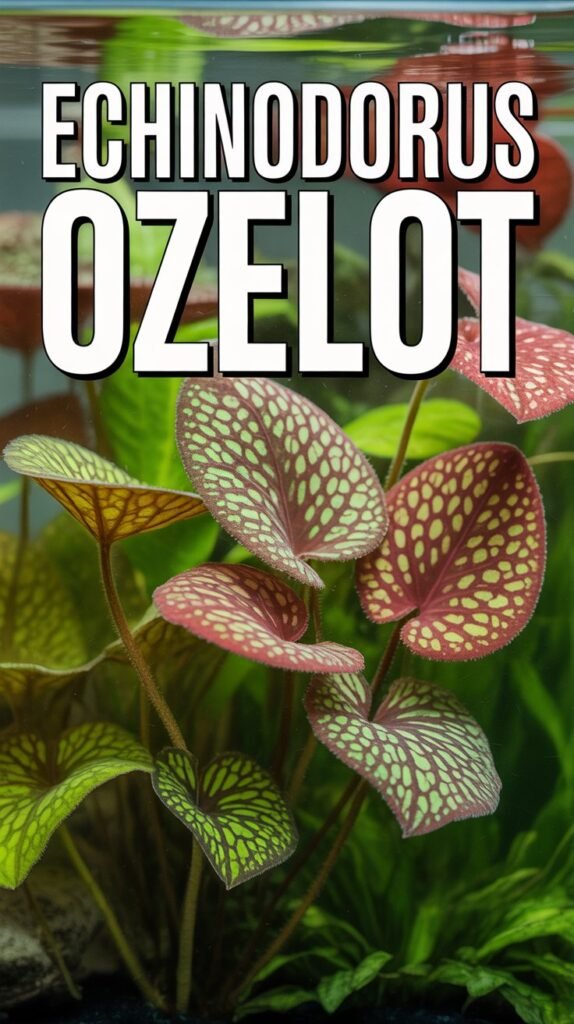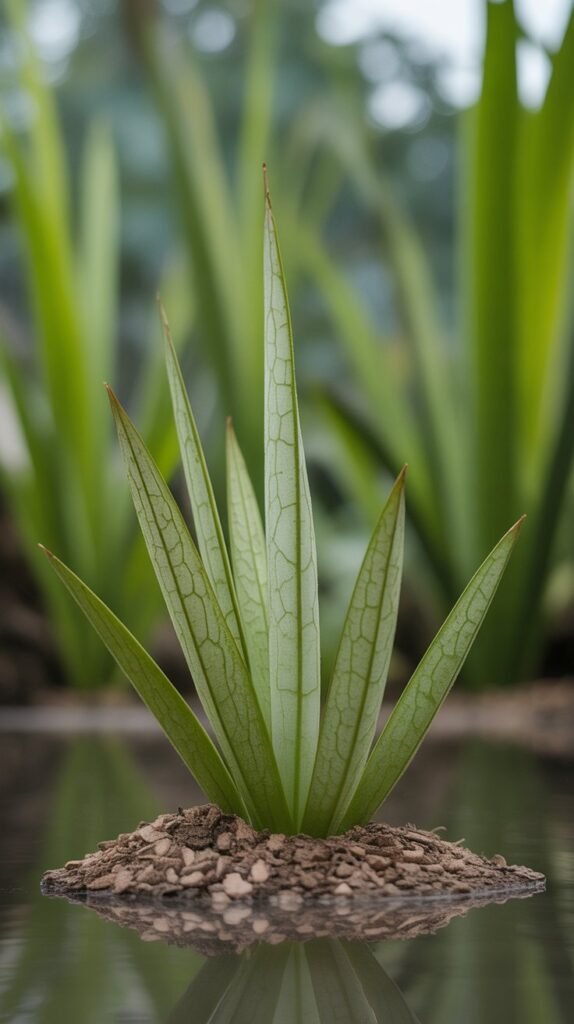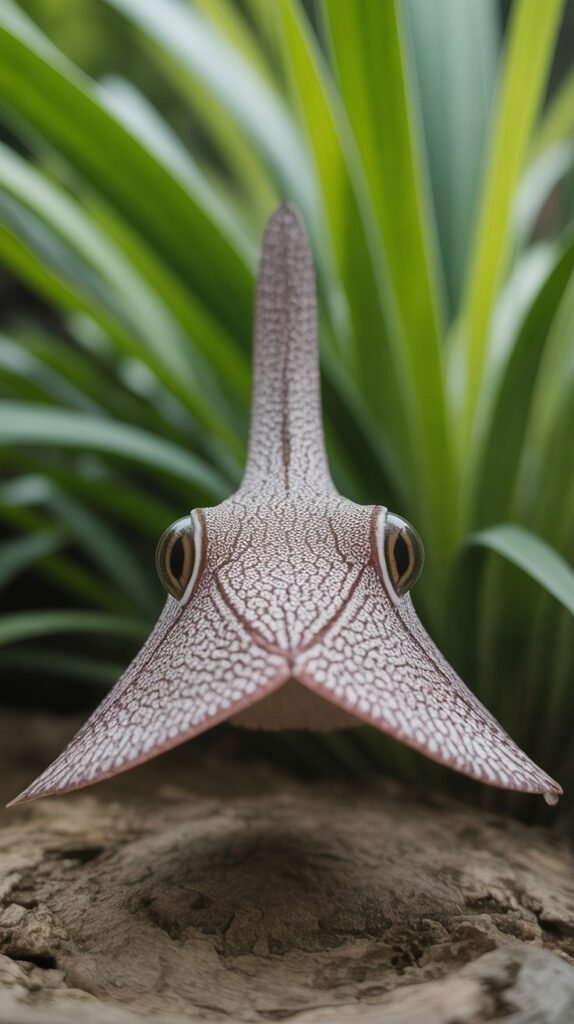If you’re looking for a visually striking aquatic plant that adds character, color, and natural elegance to your aquarium, the Echinodorus Ozelot might be the perfect choice. Known for its unique leopard-like spotted leaves, this plant brings an exotic touch to freshwater aquascapes while remaining easy to grow and maintain.
In this in-depth guide, we’ll explore everything about the Echinodorus Ozelot, including its origin, care requirements, ideal tank conditions, propagation methods, and compatibility with other aquatic life. Whether you’re a beginner or an experienced aquarist, this article will help you master the art of growing and maintaining this beautiful plant.
What Is Echinodorus Ozelot?
Echinodorus Ozelot is a hybrid aquatic plant belonging to the Alismataceae family. It’s part of the popular Echinodorus genus, which includes several well-known sword plants like Echinodorus bleheri (Amazon Sword) and Echinodorus amazonicus.
The Ozelot variety stands out for its spotted leaf pattern — resembling a leopard’s coat — which gives it the nickname “Leopard Sword Plant.” This feature makes it a favorite for aquascapers who want a vibrant focal point in their planted tanks.
It’s a hardy, adaptable, and fast-growing species that thrives in a wide range of aquarium environments, making it suitable for both beginners and advanced hobbyists.

Scientific Classification
- Scientific Name: Echinodorus Ozelot
- Common Name: Leopard Sword, Ozelot Sword Plant
- Family: Alismataceae
- Genus: Echinodorus
- Origin: Cultivated hybrid (a cross between Echinodorus schlueteri and Echinodorus barthii)
- Plant Type: Rosette plant
- Growth Rate: Moderate to fast
- Placement: Midground to background
Origin and Natural Background
Unlike wild species, Echinodorus Ozelot is a cultivated hybrid, first developed in aquatic plant farms in Asia and Europe. Its parent plants come from South American river basins, particularly the Amazon region — known for its warm, nutrient-rich waters.
This hybridization aimed to combine the robust growth of Echinodorus schlueteri with the vivid coloration of Echinodorus barthii, resulting in the stunning, spotted Ozelot we see today.
While it doesn’t have a natural habitat, its environmental preferences are similar to Amazonian plants — soft, slightly acidic water, stable warmth, and moderate light.
Physical Appearance
The Echinodorus Ozelot is easily one of the most beautiful aquatic plants available for freshwater aquariums. Its distinctive appearance makes it stand out instantly.
Key Features:
- Leaves: Oval-shaped with rich green, red, or brown tones depending on the variety and light conditions.
- Spots: Dark brown to black leopard-like spots cover the leaves, a signature trait of this plant.
- Size: Can grow between 12 to 20 inches (30–50 cm) tall.
- Growth Form: Rosette shape with multiple broad leaves radiating from a central base.
- Roots: Thick and robust, allowing for strong anchorage and nutrient absorption.
Because of its moderate height and striking leaf pattern, the Ozelot Sword works beautifully as a midground or background plant in aquascapes.
Varieties of Echinodorus Ozelot
There are a few color variants of this plant, each offering a slightly different aesthetic:
- Echinodorus Ozelot Green:
- Light to dark green leaves with black spots.
- Great for natural, jungle-style aquascapes.
- Echinodorus Ozelot Red:
- Young leaves display deep red hues that fade to bronze or green with age.
- Offers vibrant contrast in planted tanks.
- Echinodorus Ozelot Leopard:
- A term often used for the same plant, emphasizing its spotted pattern.
Each variety grows similarly but provides a different color tone, allowing you to mix and match for aesthetic variety.
Ideal Tank Conditions for Echinodorus Ozelot

To help your Ozelot Sword thrive, it’s essential to recreate the right environment. Fortunately, it’s adaptable and forgiving, but ideal conditions ensure maximum color and growth.
| Parameter | Ideal Range |
|---|---|
| Temperature | 22–28°C (72–82°F) |
| pH Level | 6.5–7.5 |
| Water Hardness | 3–10 dKH |
| Lighting | Moderate to high |
| Tank Size | Minimum 20 gallons (preferably 30+) |
| CO₂ Requirement | Optional but beneficial |
| Substrate | Nutrient-rich soil or gravel |
This plant prefers stable water parameters and clean, nutrient-rich conditions. Weekly water changes and good filtration are key to keeping it healthy.
Lighting Requirements
Lighting significantly affects the color and vibrancy of Echinodorus Ozelot.
- Moderate Light: Promotes steady growth with dark green leaves and visible spots.
- High Light: Encourages more intense coloration, especially in red varieties.
- Low Light: Plant may survive, but leaves will lose their deep coloration and spots may fade.
Provide 8–10 hours of consistent light per day using full-spectrum LED or fluorescent aquarium lights.
Substrate and Nutrient Requirements
Being a heavy root feeder, the Ozelot Sword requires a nutrient-rich substrate to support healthy growth.
Recommended Substrate Options:
- Aquarium soil enriched with organic nutrients.
- Fine gravel with root tabs added regularly.
- Avoid sharp gravel that may damage roots.
Nutrients Needed:
- Iron: Essential for deep red and green coloration.
- Potassium and Nitrogen: Promote leaf health and new growth.
- Trace Minerals: Support long-term vitality.
Use root tabs every 4–6 weeks and liquid fertilizers weekly to replenish essential nutrients.
Water Parameters and Maintenance
Echinodorus Ozelot thrives in clean, well-maintained water. Dirty or unstable tanks can cause leaf melt and algae growth.
Maintenance Tips:
- Perform 20–30% water changes weekly.
- Maintain stable temperature and pH.
- Avoid chlorine or copper in the water (use water conditioner).
- Trim old or damaged leaves regularly.
Because this plant absorbs nutrients primarily through its roots, clean substrate and balanced fertilization are crucial.
CO₂ and Fertilization
While Echinodorus Ozelot doesn’t require CO₂ injection, adding it enhances growth and coloration.
Fertilization Tips:
- Root Tabs: Place near the plant base every 1–2 months.
- Liquid Fertilizer: Add weekly to supplement micronutrients.
- Iron Supplementation: Especially for red-leaved varieties.
CO₂ Supplementation:
- Encourages lush, fast growth.
- Prevents yellowing and leaf melt.
- Reduces algae by improving plant health.
If you’re using high lighting, CO₂ injection becomes more beneficial to balance the ecosystem.
Planting Echinodorus Ozelot

Proper planting ensures quick root establishment and long-term stability.
Step-by-Step Guide:
- Gently rinse the plant to remove debris or old substrate.
- Trim off dead or damaged leaves.
- Dig a small hole in the substrate with your fingers or aquascaping tweezers.
- Insert the roots into the hole, ensuring the crown remains above the substrate.
- Gently cover the roots with substrate.
Avoid burying the crown — it can cause rot. Within a few weeks, you’ll notice new leaves sprouting.
Propagation of Echinodorus Ozelot
One of the fascinating aspects of this plant is its ease of propagation. It reproduces mainly through runners or flower stalks.
1. Runner Propagation
- Mature plants produce horizontal runners with small plantlets.
- Wait until the plantlets have developed a few leaves and roots.
- Carefully cut and replant them into the substrate.
2. Flower Stalk Propagation
- When conditions are optimal, the plant may send out a flower stalk.
- New plantlets develop along the stalk.
- Once they grow 3–4 leaves and roots, cut and plant them separately.
Propagation can occur naturally if the plant is healthy and well-fed.
Pruning and Growth Management
Because Echinodorus Ozelot grows relatively fast, regular pruning is important to maintain tank aesthetics and water quality.
Pruning Tips:
- Remove yellowing, melted, or algae-covered leaves.
- Trim larger leaves if they block light for other plants.
- Avoid excessive trimming — it can stress the plant.
- Keep a balance between root feeding and leaf maintenance.
Well-pruned plants encourage more compact and healthier growth.
Common Problems and Solutions
Even though the Ozelot Sword is hardy, it may encounter some issues. Recognizing and fixing them early ensures lasting health.
1. Yellowing Leaves
Cause: Iron or nutrient deficiency.
Solution: Add iron-rich fertilizers or root tabs.
2. Melting Leaves After Planting
Cause: Transition stress (emerse to submerse form).
Solution: Wait 1–2 weeks; new submerged leaves will grow.
3. Algae Growth
Cause: Excess light or nutrients.
Solution: Reduce lighting hours, improve filtration, and avoid overfeeding.
4. Stunted Growth
Cause: Poor substrate nutrition or low light.
Solution: Increase light intensity and add root fertilizers.
5. Crown Rot
Cause: Planting too deep.
Solution: Keep crown slightly above the substrate.
Most issues are easy to resolve with proper lighting, nutrition, and water maintenance.
Tank Mates for Echinodorus Ozelot
The Ozelot Sword is peaceful and compatible with almost all freshwater fish and invertebrates.
Best Tank Mates:
- Guppies
- Tetras (Neon, Cardinal, Rummy Nose)
- Rasboras
- Angelfish
- Dwarf Gouramis
- Corydoras Catfish
- Shrimp and Snails
Avoid:
- Goldfish (they uproot plants)
- Large Cichlids (can damage leaves)
- Plecos that eat delicate plant tissue
It’s also an excellent plant for community tanks and biotope setups that replicate South American environments.
Aquascaping Ideas with Echinodorus Ozelot
Echinodorus Ozelot is a dream for aquascapers because of its unique spotted texture and vivid coloration.
Aquascaping Uses:
- Background Focal Plant: Use as a centerpiece in larger tanks.
- Midground Accent: Place alongside shorter plants for layered composition.
- Amazon or Jungle Theme: Pair with driftwood, rocks, and other sword plants.
- Contrast Effect: Combine red and green varieties for visual diversity.
The Ozelot Sword adds warmth and depth to aquascapes, especially in tanks with green foreground carpeting plants like Hemianthus callitrichoides or Monte Carlo.
Advantages of Echinodorus Ozelot
- Visually Stunning: The leopard-like spots make it one of the most attractive aquatic plants.
- Hardy and Adaptable: Suitable for beginners and experts alike.
- Low Maintenance: Grows well under moderate lighting.
- Excellent Oxygenator: Improves tank oxygen levels and water quality.
- Provides Shelter: Offers hiding spots for fry and small fish.
- Versatile Placement: Works well in both midground and background.
- Long Lifespan: Can live for years in stable aquarium conditions.
Disadvantages or Challenges
- Can Grow Large: May outgrow smaller tanks quickly.
- Needs Nutrient-Rich Substrate: Root feeding is essential.
- Sensitive to Crown Depth: Easily develops crown rot if planted incorrectly.
- Can Shade Other Plants: Requires occasional pruning.
Despite these minor challenges, Echinodorus Ozelot remains one of the most rewarding aquarium plants to grow.
Echinodorus Ozelot vs. Echinodorus Bleheri
| Feature | Echinodorus Ozelot | Echinodorus Bleheri (Amazon Sword) |
|---|---|---|
| Leaf Pattern | Spotted (leopard-like) | Plain green |
| Color Variants | Green, Red | Mainly green |
| Size | Medium (12–20 inches) | Large (up to 24 inches) |
| Growth Rate | Moderate to fast | Fast |
| Lighting | Moderate to high | Moderate |
| Placement | Midground/Background | Background |
Ozelot is the better choice for those who want color and texture, while Bleheri suits those who prefer a classic green centerpiece.
Tips for Success with Echinodorus Ozelot
- Use nutrient-rich substrate or root tabs regularly.
- Maintain consistent lighting (8–10 hours daily).
- Provide moderate filtration and weekly water changes.
- Avoid burying the crown too deep.
- Supplement with iron for brighter colors.
- Trim dead leaves to encourage new growth.
- Pair with peaceful tank mates.
- Add CO₂ if using strong lighting for faster, more vibrant results.
With these simple practices, your Echinodorus Ozelot will stay healthy and visually captivating.
Conclusion
The Echinodorus Ozelot is a perfect blend of beauty, resilience, and versatility. Its vibrant spotted leaves and sturdy nature make it one of the most eye-catching sword plants available for aquariums. Whether you’re designing a lush jungle-style aquascape or a simple planted community tank, the Ozelot Sword will be a showstopper.
With proper lighting, nutrition, and care, this plant grows gracefully, enriching your aquarium ecosystem while creating a serene, natural aesthetic. Few plants combine such elegance and ease of maintenance — making Echinodorus Ozelot a must-have for every aquascape enthusiast.
FAQs About Echinodorus Ozelot
1. What is Echinodorus Ozelot?
Echinodorus Ozelot is a hybrid aquatic plant known for its spotted leaves, belonging to the sword plant family. It’s often called the Leopard Sword due to its distinctive pattern.
2. How big does Echinodorus Ozelot grow?
It typically reaches 12–20 inches (30–50 cm) tall, depending on tank conditions.
3. Does Echinodorus Ozelot need CO₂?
No, it doesn’t require CO₂, but adding it can boost growth and enhance leaf coloration.
4. Can I grow Echinodorus Ozelot in low light?
Yes, it will survive, but the colors and spots will be less vibrant.
5. How do I propagate Echinodorus Ozelot?
Propagation occurs through runners or flower stalks that produce plantlets. Replant these once they develop roots.
6. Why are the leaves melting?
This is common when the plant transitions from emersed to submerged form. New leaves will grow soon.
7. How often should I fertilize?
Use root tabs every 4–6 weeks and add liquid fertilizer weekly.
8. What’s the best tank size for Echinodorus Ozelot?
A minimum of 20 gallons is recommended, though larger tanks allow for full growth.
9. Is it compatible with shrimp and snails?
Yes, it’s perfectly safe and even provides shelter for them.
10. What’s the difference between Echinodorus Ozelot Red and Green?
The Red variety has reddish leaves when young, while the Green version remains bright green with black spots.

